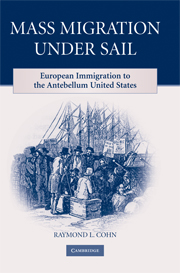Book contents
- Frontmatter
- Contents
- List of Tables and Figures
- Preface
- 1 A Unique Period for Immigration
- 2 The Onset and European Origins of Mass Immigration
- 3 The Jump in Immigrant Volume Around 1830
- 4 Push, Pull, and Other Factors in Antebellum Immigration
- 5 Who Were the Immigrants?
- 6 The Trip from Europe to the United States
- 7 The Immigrants in the United States
- 8 The Effects of Immigration on the United States
- 9 The End of Mass Migration Under Sail
- References
- Index
7 - The Immigrants in the United States
Published online by Cambridge University Press: 30 June 2009
- Frontmatter
- Contents
- List of Tables and Figures
- Preface
- 1 A Unique Period for Immigration
- 2 The Onset and European Origins of Mass Immigration
- 3 The Jump in Immigrant Volume Around 1830
- 4 Push, Pull, and Other Factors in Antebellum Immigration
- 5 Who Were the Immigrants?
- 6 The Trip from Europe to the United States
- 7 The Immigrants in the United States
- 8 The Effects of Immigration on the United States
- 9 The End of Mass Migration Under Sail
- References
- Index
Summary
Chapter 6 discussed the trip of the European immigrants up to their arrival in the United States. This chapter investigates what happened then. The immigrants arrived at a number of U.S. ports and the figures for arrivals at each port are presented. However, most of the immigrants did not stay in the arrival port. Therefore, this chapter examines their geographic location in 1850. Because of financial or health limitations, not all of the immigrants who wanted to leave the city at which they arrived found it easy to do so. The large volume of arrivals in New York City, in fact, led the state to create the Commissioners of Emigration of the State of New York in 1847, as noted in the last chapter. Their operations in assisting the arriving immigrants are discussed in detail in this chapter. The large majority of immigrants who left the port cities went to locations where jobs were available and the types of jobs the immigrants obtained are examined. These data are then used to determine whether the immigrants achieved economic success in the U.S. labor market. The facts that immigration continued and rose in volume and that many early immigrants were able to assist others to migrate implies that the immigrants were better off in the United States, a supposition reinforced by the findings in this chapter.
- Type
- Chapter
- Information
- Mass Migration under SailEuropean Immigration to the Antebellum United States, pp. 155 - 189Publisher: Cambridge University PressPrint publication year: 2008

